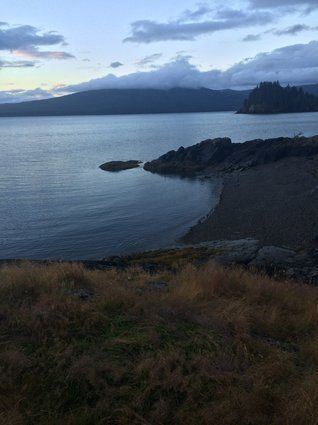
"You're going where?!"
That was the most common question I heard, when I announced to friends in New York City that I was flying over 3,000 miles to Haida Gwaii to run a marathon this summer. A little incredulous, and a lot suspicious, as if there was some ulterior motive involved.
Haida Gwaii: Most New Yorkers have never even heard of it, let alone formed an opinion of it. Heck, most New Yorkers don't like to travel to their neighbouring borough. To a diehard Manhattanite, Brooklyn or Queens is essentially another planet.
And here I was taking off to Haida Gwaii, formerly known as the Queen Charlotte Islands, a misty archipelago off the coast of northwest B.C. Beyond its shores, nothing but thousands of miles of Pacific Ocean. They don't call it the "Edge of the World" for nothing.
"And you're going to do what?!"
That was always the next question. The answer: I was going to run the Totem to Totem, an intimate little 26.2-mile marathon alongside some of the most spectacular coastline on planet Earth. Just a handful of runners, snaking through the historic village of Skidegate, beneath the towering pines and spruces and firs of West Coast forest.
And that, right there, was why I had come so far. It wasn't just any run: It felt more like a sacred trek through territory of the Haida Nation. In fact before the run, race organizer David Seymour had to ask permission from the local chief, for a crew of such sweaty interlopers to traipse through their land. (It was granted, thankfully.)
Most marathons are about cold numbers: A finishing time, a per-mile pace. This one was more about symbols, and stories. Just look at the starting line itself: Nestled in the shadow of the historic totem poles of the Haida Heritage Centre, each one telling its own unique story of clan and spirits.
"Hawaa," Seymour said to the chief -- "thank you," in the endangered Haida language -- and we were off.
As the miles clocked by, I reflected on how challenging this magical place had been to get to. A six-hour redeye flight from NYC, a half-day stopover in Vancouver, then two more hours in an Air Canada flight up the coast. Oh, and then a ferry. (No one told me about the ferry.)
But this trip wasn't about ease. After spending almost 15 years abroad in the U.S., it was about reconnecting with the heart and soul of British Columbia: The vistas of Pacific beaches, the calls of the ravens at daybreak, the natural spirits that populate every curve in the coastline.
It was about meeting people like Guujaaw, longtime head of the Haida nation, who had been involved in the historic logging blockade at Lyell Island so many years ago. It was about sharing a salmon dinner at the community hall with Roy Jones, one of the last remaining speakers of the Haida tongue.
What's strange is that for such an ancient and remote place, Haida Gwaii finds itself at the nexus of so many critical modern debates. Enbridge and oil pipelines. Native land title. Geoengineering to repopulate rivers and oceans. Fukushima, whose debris is still drifting across the ocean onto local shores.
But none of those debates were heard on marathon day, as we churned 13.1 miles up the highway to the turnaround point of St. Mary's Spring. The local legend: If you drink from the spring's waters, you will always come back to the islands.
No sounds of the rest of the world falling apart, either. Nothing about chaos in Ferguson, Mo., or the horrors in the distant Mideast. Just the cool Pacific winds, and the low rhythm of the waves, and the sight of the occasional bald eagle tracing our path.
All marathoners know that you find out a lot about yourself after mile 20. As the saying goes, the first 10 miles are about the fitness of your body, the next 10 are about your mind, and the final 6.2 are about your heart.
When every part of your body feels like it is falling apart, when every ounce of energy has been used up -- then what? Do you have the ability to find some new source deep within, and go on?
Another thing runners know, deep in their core, is that you can't really do it alone. To run that far, and that long, you usually end up appealing for a little supernatural help.
As for me, I leaned heavily on the Haida spirits that day to carry me across the finish line. And they answered. To which I say: Hawaa.
